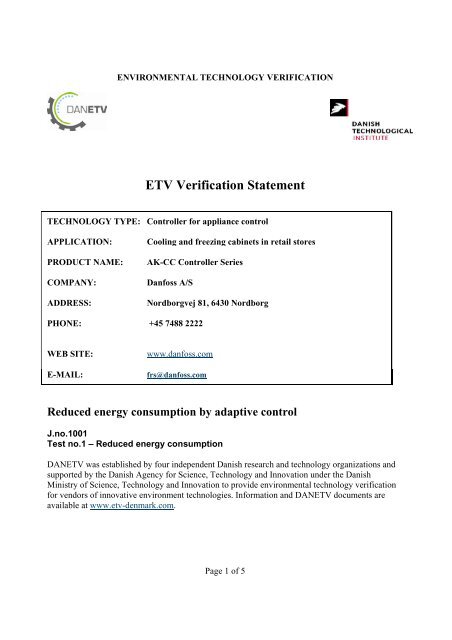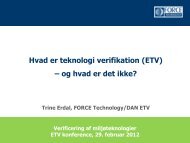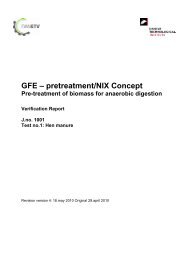ETV Verification Statement Reduced energy consumption - DANETV
ETV Verification Statement Reduced energy consumption - DANETV
ETV Verification Statement Reduced energy consumption - DANETV
Create successful ePaper yourself
Turn your PDF publications into a flip-book with our unique Google optimized e-Paper software.
ENVIRONMENTAL TECHNOLOGY VERIFICATION<br />
<strong>ETV</strong> <strong>Verification</strong> <strong>Statement</strong><br />
TECHNOLOGY TYPE: Controller for appliance control<br />
APPLICATION: Cooling and freezing cabinets in retail stores<br />
PRODUCT NAME: AK-CC Controller Series<br />
COMPANY: Danfoss A/S<br />
ADDRESS: Nordborgvej 81, 6430 Nordborg<br />
PHONE: +45 7488 2222<br />
WEB SITE: www.danfoss.com<br />
E-MAIL: frs@danfoss.com<br />
<strong>Reduced</strong> <strong>energy</strong> <strong>consumption</strong> by adaptive control<br />
J.no.1001<br />
Test no.1 – <strong>Reduced</strong> <strong>energy</strong> <strong>consumption</strong><br />
DAN<strong>ETV</strong> was established by four independent Danish research and technology organizations and<br />
supported by the Danish Agency for Science, Technology and Innovation under the Danish<br />
Ministry of Science, Technology and Innovation to provide environmental technology verification<br />
for vendors of innovative environment technologies. Information and DAN<strong>ETV</strong> documents are<br />
available at www.etv-denmark.com.<br />
Page 1 of 5
VERIFICATION AND TEST DESCRIPTION<br />
<strong>Verification</strong> and tests were performed by Danish Technological Institute (DTI) under DAN<strong>ETV</strong> and<br />
by contract with Danfoss A/S.<br />
The verification was planned and conducted to satisfy the requirements of the <strong>ETV</strong> scheme<br />
currently being established by the European Union (EU- <strong>ETV</strong>).<br />
The test organization is shown in figure 1.<br />
The day-to-day operations of the verification and tests were coordinated and supervised by DTI<br />
personnel, with the participation of the vendor, Danfoss A/S.<br />
Experts from DTI Test Centre (test sub-body) performed all testing for <strong>energy</strong> <strong>consumption</strong> and<br />
temperature levels.<br />
DTI<br />
Organization<br />
Management<br />
Test Centre<br />
<strong>Verification</strong> subbody<br />
Expert<br />
group<br />
DAN<strong>ETV</strong><br />
Steering<br />
Committee<br />
DTI Test Centre<br />
Test Centre<br />
Test sub-body<br />
Figure 1:- <strong>Verification</strong> organization.<br />
Page 2 of 5<br />
Analytical<br />
Laboratory
Table 1: Responsible personnel in the test organization.<br />
Test and <strong>Verification</strong> Center Danish Technological Institute (DTI)<br />
<strong>Verification</strong> Centre<br />
Refrigeration and Heat Pump Technology<br />
<strong>Verification</strong> responsible Bjarke Paaske<br />
Test responsible Klaus Frederiksen<br />
Address: Kongsvang Allé 29<br />
8000 Aarhus C<br />
Telephone: +45 72201000<br />
E‐mail: bjpa@teknologisk.dk<br />
Web: www.teknologisk.dk<br />
Test plan<br />
The product test consists of two similar test series at different ambient conditions representing small<br />
retail stores located in Denmark. Energy <strong>consumption</strong> and temperature levels are analyzed during<br />
the tests. One test series will be carried out by using predefined default settings on rail heat and<br />
defrost and another series will be carried out by using adaptive rail heat and defrost. The effect of<br />
the adaptive functions in AK-CC controllers are verified by comparing the results.<br />
The performance test is based on the existing European Standard ISO 23953. ISO 23953 is the<br />
standard performance test for freezing cabinets, measuring both power <strong>consumption</strong> and cooling<br />
ability. It is important to notice that ISO 23953 is a performance test of the cabinet – not the<br />
controller. By comparing several performance tests of the cabinet, using default and adaptive<br />
settings, the effect of adaptive control will be proven through the performance of the cabinet.<br />
Quality assurance<br />
The quality assurance includes control of the data quality and integrity. The test plan, test report,<br />
verification protocol and verification report have been reviewed by experts at DTI and by external<br />
members of the expert group as described in a quality manual and DAN-<strong>ETV</strong> standard procedures.<br />
Technology and product description<br />
AK-CC controllers are complete refrigeration appliance controllers for a great number of different<br />
refrigeration appliances and cold store rooms.<br />
The controller is an electronic unit that controls the different functions of a cooling application. In<br />
applications with cooling and freezing cabinets the main functions of the controller are: liquid<br />
injection of refrigerant in the evaporators, monitoring of superheat, defrosting of evaporators, rail<br />
heat, control of compressors, control of night blinds and control of lights.<br />
The verification process concerns two <strong>energy</strong> reducing features in Danfoss AK-CC controllers. One<br />
feature is automatic adaptation of rail heat. The other is adaptation of defrost sessions. The<br />
necessity of both rail heat and defrost depends on the current humidity level in the surrounding air.<br />
Page 3 of 5
The controller monitors the current dew point of the ambient air all the time. The controller then<br />
calculates the amount of heat necessary to avoid water vapor condensation at the cabinet and<br />
provides the amount of heat accordingly. In that way, excessive rail heat is eliminated.<br />
Defrost is necessary when a certain amount of frost is formed at the evaporator. The adaptive<br />
function is able to monitor the amount of ice at the evaporator and initiate defrost sessions only<br />
when necessary. In that way, excessive defrost sessions are eliminated.<br />
The verification process regards the total electrical <strong>energy</strong> reduction of both technologies. The<br />
temperature of the cooled products must not reach higher levels when applying the technology - not<br />
even briefly.<br />
VERIFICATION RESULTS<br />
Table 2: Target and measured values of tested parameters.<br />
Parameters Target<br />
Page 4 of 5<br />
Measured<br />
value Method<br />
Overall performance<br />
Total electrical <strong>energy</strong> reduction 15 % 15.1 % TI‐DOP<br />
Reduction of average temperature levels > 0 K 0.35 K TI‐DOP<br />
Reduction of peak temperature levels > 0 K > 0.4 K TI‐DOP<br />
Water vapor condensation (running water) None None Visual inspection<br />
It is important to note that the results were reached when testing one single freezing cabinet under<br />
certain conditions. The test matrix is designed to reflect conditions in small retail stores in Denmark<br />
without air conditioning and with long opening hours.<br />
The effect of the product will vary in different applications, settings, environments, locations etc.<br />
The target verified during this process will not be achievable in all installations.<br />
The performance test was carried out by completing five test samples with different ambient<br />
conditions to represent the annual variations of humidity in Denmark. The 1 st sample had low<br />
humidity levels representing winter time and the 5 th sample represented summer time using high<br />
humidity levels. Each sample consists of two test runs – one using the standard control method and<br />
one using the adaptive functions of the controller.<br />
However, the freezing cabinet used for this verification was not able to cope with the highest<br />
humidity levels and it was not possible to obtain a valid result of sample no. 5. Therefore, the 5 th<br />
sample was neglected and the effect during that period was regarded as 0, when determining the<br />
annual result.
The overall test results are summarized in table 2 below. Results from sample five are neglected<br />
because of improper functioning of the freezing cabinet.<br />
Table 3: Average and maximum temperature of the measuring packages, total electrical <strong>energy</strong> <strong>consumption</strong><br />
(24h period) and the effect of the product in the specific samples. To the right, the average annual<br />
temperature and <strong>energy</strong> reduction (effect) are shown.<br />
Sample<br />
1<br />
2<br />
3<br />
4<br />
5<br />
Temperature [° C] Energy Results Average<br />
Run Package Package Total Temp. Energy Temp. Energy<br />
no. average max. [kWh] diff. [K] red. Factor red. [K] red.<br />
1<br />
2<br />
‐17.15<br />
‐17.60<br />
‐11.44<br />
‐12.32<br />
29.1<br />
20.7<br />
‐0.45 29 % 0.09<br />
3<br />
4<br />
‐17.21<br />
‐17.61<br />
‐11.25<br />
‐12.45<br />
29.2<br />
21.6<br />
‐0.39 26 % 0.17<br />
5<br />
6<br />
‐17.10<br />
‐17.42<br />
‐10.90<br />
‐11.32<br />
30.1<br />
25.2<br />
‐0.32 16 % 0.39 ‐0.35 15.1 %<br />
7<br />
8<br />
‐16.81<br />
‐17.33<br />
‐9.64<br />
‐10.73<br />
31.6<br />
29.3<br />
‐0.52 7 % 0.23<br />
9<br />
10<br />
‐<br />
‐<br />
‐<br />
‐<br />
‐<br />
‐<br />
0.00 0 % 0.12<br />
It is concluded for Danfoss AK-CC Controllers:<br />
• For this type of application, the adaptive control method gives an annual reduction in<br />
electrical <strong>energy</strong> <strong>consumption</strong> of the cabinet of 15.1 %.<br />
• Using the adaptive control method gives an annual average temperature reduction of<br />
0.35 K of the cooled products for this type of cabinet.<br />
• Using the adaptive control method gives reduced water vapor condensation for this type of<br />
cabinet (running water was only present in run 7).<br />
• The result of this verification process is very dependent on the type of cabinet used as well<br />
as geographical location, settings, opening hours etc. It is likely that the adaptive control<br />
method will have a different influence on other types of cabinets in different applications.<br />
Responsible for this verification are:<br />
Original signed 06/05/10 by:<br />
Bjarke Paaske, Consultant<br />
DTI – Refrigeration and Heat Pump Technology<br />
___________________________________<br />
Page 5 of 5<br />
Original signed 06/05/10 by:<br />
Klaus Frederiksen, Consultant<br />
DTI – Refrigeration and Heat Pump Technology<br />
___________________________________





